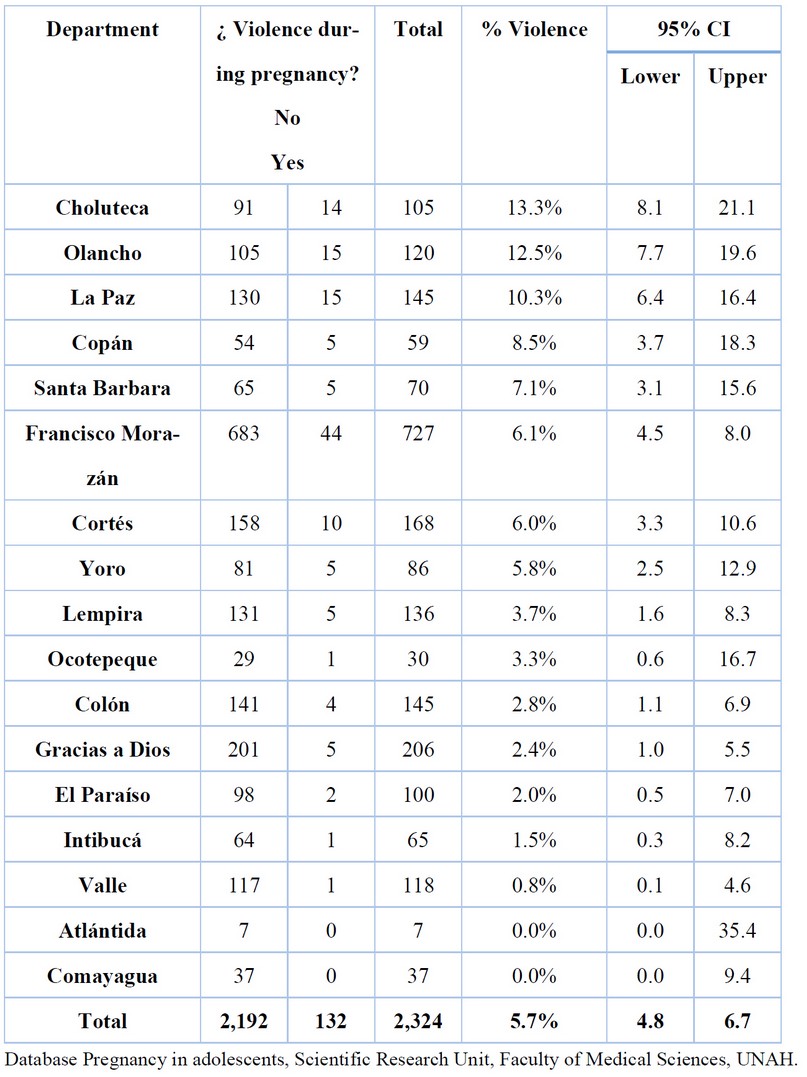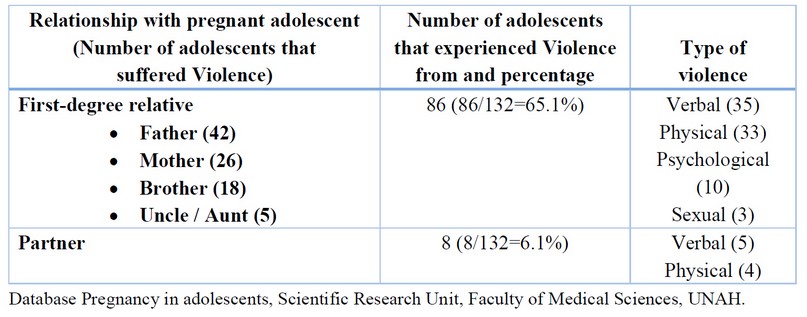2023.08.03.40
Files > Volume 8 > Vol 8 No 3 2023
Teenage pregnancy and Violence: A current public health problem.
Itzel Carolina Fuentes-Barahona1,4 , Manuel Antonio Sierra-Santos2
, Manuel Antonio Sierra-Santos2 , Lysien Ivania Zambrano3,4*
, Lysien Ivania Zambrano3,4* , Eleonora Espinoza- Turcios 2,5
, Eleonora Espinoza- Turcios 2,5 , Iván Alfonso Espinoza-Salvadó2
, Iván Alfonso Espinoza-Salvadó2 .
.
1 Department de Gynecology, Hospital School Tegucigalpa, Honduras.
2 Faculty of Medical Sciences (FCM), National Autonomous University of Honduras (UNAH). Tegucigalpa, Honduras.
3 Department of Morphological Sciences, Faculty of Medical Sciences (FCM), National Autonomous University of Honduras (UNAH). Tegucigalpa, Honduras.
4 GRINVAR Research Group.Tegucigalpa, Honduras
5 Mental Health Research Group.Tegucigalpa, Honduras
Available from: http://dx.doi.org/10.21931/RB/2023.08.03.40
Dear Editor
Every year, an estimated 21 million teenage girls aged 15–19 years become pregnant, and at least 777,000 births occur to adolescent girls younger than 15 years in developing countries. 1 Latin America has the world's second highest teenage pregnancy rate, with about 18 % of births to mothers under 20. Each year, one and a half million adolescent women aged 15 and 19 have babies in the region.2 Injuries, Violence, self-harm, and maternal conditions are the leading causes of death among adolescents and young adults. Pregnant teenagers are prime targets of different types of Violence. Violence and adolescent pregnancy are public health problems and risk factors for maternal and fetal morbidity and mortality. The United Nations Sustainable Development Cooperation Framework (UNSDCF) prioritizes ending Violence against girls and child marriage.3,4

Figure 1. Latin America has the world's second highest teenage pregnancy rate, with about 18 % of births to mothers under 20. 32242354 © Breakers | Dreamstime.com
Honduras is still one of the most violent countries in the world, with a homicide rate of nearly 50 per 100,000 by the end of 2022 and the fifth-highest rate of Violence against women worldwide. From 2005 to 2020, 6,458 violent deaths were reported in women, 8.7% corresponded to children under 186
Violence and teenage pregnancy are public health problems; according to UNICEF data, 14.7% of adolescent girls between 15 and 19 years old said they had suffered physical Violence in their home, 49% came from a father or mother and 25% from a housemate. Some observations report up to 25% psychiatric comorbidity.7 What has defined four types of perpetrators of physical Violence: 1) Parents or guardians, 2) Intimate partners, 3) Peers of the same age, 4) other adults in the community? About 46.5% of women victims of Violence the first incident had been at the ages of 6-11 years.8
A cross-sectional study was carried out from August 2015 to August 2016 in a convenience sample of 2,324 pregnant adolescents living in rural and semi-urban areas of Honduras. The unit of analysis was pregnant adolescents between 10 and 19 years of age inclusive and who had a positive pregnancy test (positive gravindex) or diagnosis by ultrasonography (USG) or which were evident by clinical evaluation and who attended their prenatal check-up to be attended by doctors in social service.
This study included variables such as gynecologic-obstetric history (menarche, number of partners, sexually transmitted infections, family planning), personal pathological history (previous illnesses, Violence, alcohol, tobacco, drug use) and family history (chronic diseases and Violence). Honduran "departments" with predominant rural communities had higher rates of reported Violence: Choluteca 13% (14/105), Olancho 12.5% (15/120), La Paz 10.3% (15/145). (Table 1).

Table 1. Reported Violence among pregnant adolescents, with 95% confidence intervals. Honduras, (n= 2,324).
A total of 5.7% (132/2,324) reported some violence: verbal 30.3% (40/132), physical 28.0% (37/132), psychological 7.5% (10/132), and sexual 2.3% (3/132) The main perpetrators of Violence against teenage pregnant women were first-degree relatives, especially the parents, the most frequent types of Violence reported were: verbal Violence. (Table 2)

Table 2. Pregnant adolescents with experience of Violence and their relationship with the perpetrator and the type of Violence attended in the areas of influence of medical in Social Service. (n= 132)
CONCLUSIONS
Violence and adolescent pregnancy are public health problems and important factors that increase morbidity and mortality during pregnancy with increased risk of adverse outcomes. Teen pregnancy is an ongoing problem related to low socioeconomic levels, family instability, child maltreatment, and Violence. Continuous support must be given to pregnant adolescents, with a psychologist, where the issue is addressed; support is provided, and this can be avoided, especially in the departments where the highest rates were reported. Guaranteeing respect and rights in childhood and adolescence is a pillar of human development, preventing the harm and stigma left by Violence in childhood.
Institutional Review Board Statement: The study was conducted under the Declaration of Helsinki. This research's preparation and execution fully complied with the fundamental ethical principles of autonomy, justice, beneficence, and non-maleficence. They were approved by the Ethics Committee in Biomedical Research (CEIB) of the National Autonomous University of Honduras (UNAH), meeting of March 18, 2016.
Acknowledgments: All the cohorts of Medical in Social Service (MSS) 2015-2016 were responsible for data collection and accepted to participate in the project, to the directors of the healthcare centers in the areas that participated in the study, to the teachers of the UIC, for all the support provided in the review of the MSS assigned to each one. To Dr. Sarmiento for the support in the training workshops for the MSS, To David Naira for designing the database, and to Henry Castro.
Conflicts of Interest: The authors declare no conflict of interest.
Key Words: Pregnancy in Adolescence, Violence, Honduras.
REFERENCES
1. World Health Organization. Adolescent and young adult health; 2022 [cited 2022 August 26]. Available from: URL: https://www.who.int/news-room/fact-sheets/detail/adolescents-health-risks-and-solutions.
2. UNFPA. Socioeconomic consequences of adolescent pregnancy in six Latin American countries; 2020 [cited https://lac.unfpa.org/sites/default/files/pub-pdf/eng_-_informe_consecuencias_socioeconomicas_del_embarazo_en_la_adolescencia_en_seis_paises_de_america_latina_y_el_caribe._vf.pdf].
3. Eliner Y, Gulersen M, Kasar A, Lenchner E, Grünebaum A, Chervenak FA et al. Maternal and Neonatal Complications in Teen Pregnancies: A Comprehensive Study of 661,062 Patients. J Adolesc Health 2022; 70(6):922–7.
4. Patience Lily Alidri. UN Cooperation Framework Internal Guidance -- June 1 2022; 2019.
5. IUDPAS, UNAH, Ministerio Público. Boletin Muerte Violenta de Mujeres y Femicidios: Resultados del análisis enero-diciembre 2020.
6. INE, SESAL. Encuesta Nacional de Demografía y Salud/ Encuesta de Indicadores Múltiples por Conglomerados: (ENDESA/MICS 2019); 2019.
7. Fortin-Langelier E, Daigneault I. Childhood sexual abuse, teenager pregnancy and the mediating role of psychiatric comorbidity. Children and Youth Services Review 2022; 138:106509. Available from: URL: https://www.sciencedirect.com/science/article/pii/S0190740922001451.
8. SESAL, INE, CDC. Encuesta de Violencia contra Niños, Niñas y adolescentes; 2017.
Received: 20 June 2023/ Accepted: 25 August 2023 / Published:15 September 2023
Citation:Fuentes-Barahona I.C; Sierra-Santos M.A; Zambrano L.I; Espinoza-Turcios E; Espinoza-Salvadó, I.A. Teenage pregnancy and Violence: A current public health problem.
Revis Bionatura 2023;8 (3) 40. http://dx.doi.org/10.21931/RB/2023.08.03.40
